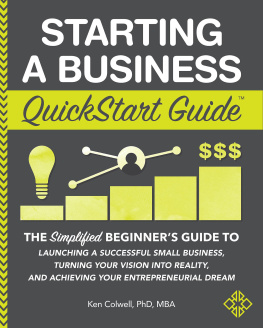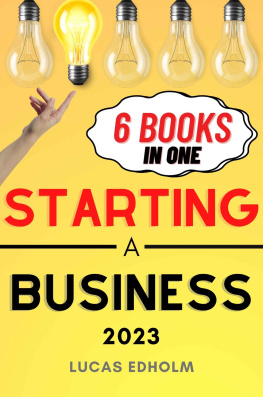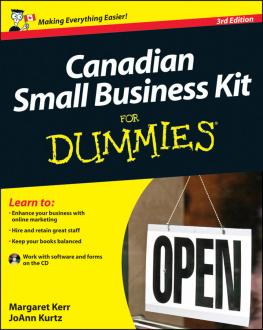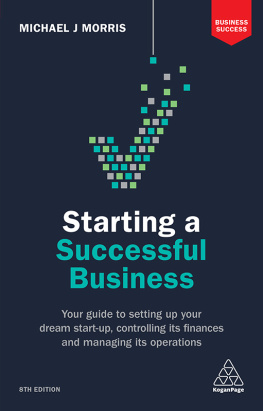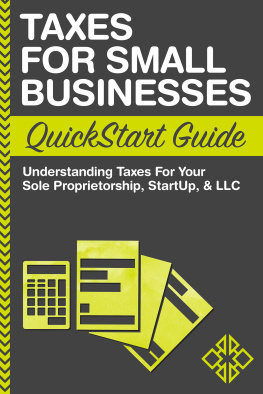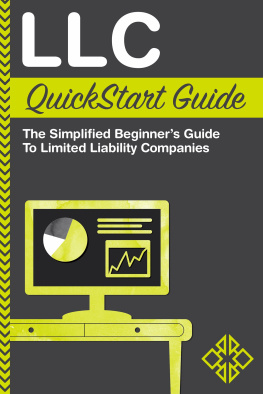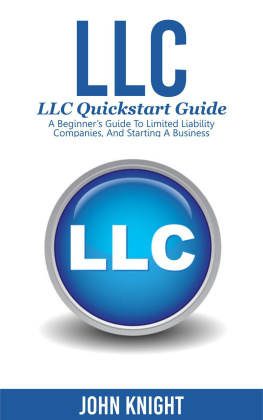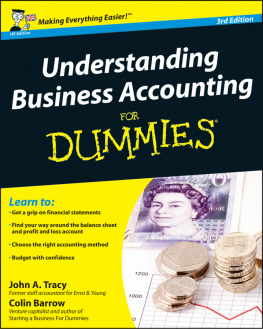
Contents

www.clydebankmedia.com/business-campus

BEFORE YOU START READING,
DOWNLOAD YOUR FREE DIGITAL ASSETS!
Visit the URL below to access your free Digital Asset files that are included with the purchase of this book.

DOWNLOAD YOURS HERE:
www.clydebankmedia.com/business-assets
Introduction
Thisis a book for people who are interested in starting a business.
Maybeyou have an unfulfilled passion that you want to transform into yourlivelihood. Maybe you hate your job and want to get off the corporatetreadmill. Maybe you dream of financial independence and want to beyour own boss. Or perhaps you are a willing (or unwilling)participant in the gig economy and want to learn how tomake a living at it. Perhaps youve even started a businessbefore but arent quite sure youve got everythingfigured out. Whatever your circumstance, you will find value in thisbook.
Ivespent over twenty years in the new venture ecosystem as anentrepreneurship professor, consultant, business school dean, andfounder of my own ventures. When I began working with entrepreneurs,starting a business was hard and expensive. The dot-com boom and bustof the late 1990s/early 2000s demystified the process for the generalpublic and made successful entrepreneurs into rock stars. Since then,technology has made starting a business much easier and lessexpensive, and self-employment is now a highly desirable career pathfor many.
Yetthere are still profound misunderstandings among the general publicabout how to start and run a successful business. Thesemisunderstandings are amplified by fawning press accounts that makeextreme outliers of entrepreneurial success seem like the norm, aswell as lifestyle-oriented blogs, books, and podcasts that makestarting and running a business seem as easy as falling off a log.
Myintent is to interject a dose of reality into all the hype. Yes,starting a business can be tremendously rewarding bothpsychologically and (possibly) monetarily. But it is also very hardwork and will completely dominate your life, especially at first. Youwill have to deal with constant risk and uncertainty. How youapproach these things will largely determine how successful you canbe.
How This Book Is Organized
Thisbook starts at the most fundamental levelthe mindset andcognitive factors critical to success as an entrepreneur. Theresa reason for this. In my 20-plus years working in the entrepreneurialecosystem, Ive found time and again that the right mindset isfar more important to the success of a new venturethan economic factors, airtight intellectual property protection, orkiller financial projections. Over and over again Ive seenventures fail that seemed to have everything going for them. Ivealso seen too many ventures to count that succeeded despite so-calledexperts (i.e., me) thinking they had no chance at all.The intangibles are usually far more important than the tangibles inall creative domains, and, as you will see, I view starting a newventure as the ultimate creative act.
Thenext section of the book outlines the strategic issues youregoing to have to grapple with in order to determine the two mostcritical elements of a new ventureyour value proposition andyour business model. Your value proposition lays out who yourcustomers are and how you distinguish yourself from your competition.Your business model addresses how you will run your business and howyou will meet your profitability goals.
Finally,I include a basic outline of a traditional business plan withspecific instructions for how to write it. Although many of you haveno need for a formal business plan, there are good reasons to pullall of your thinking and planning into a series of concise, usefuldocuments and other media, and Ill go over how to do so.
Althoughthis book is intended for everyone in the entrepreneurial ecosystem,I am focusing on the 99 percent of entrepreneurs who are not lookingto raise large amounts of capital to rapidly scale into an eight-figure company. I will certainly touch on the different ways toraise money and the venture capital process, but this is onlyrelevant to the vast majority of nascent entrepreneurs as a point ofinterest.
Ifyou are reading this book, chances are youre seriously considering delving into the complicated, exhilarating, frustrating,and rewarding world of entrepreneurship. Congratulations! It wontbe easy, but it may just be the best thing youve ever done. Ilook forward to helping you begin your journey.
Chapter by Chapter
Chapter 1: Your Big Idea discusses the nature of opportunities. Believe it or not, not all ideas are created equal, and being able to discern the difference between an idea and an opportunity is one of the first steps to getting started on your own entrepreneurial path. In this chapter you will learn where opportunities come from and what makes an opportunity great.
Itsno secret that starting your own business comes with significantrisk and a mountain of hard work. For many new entrepreneurs theirbiggest obstacle is their own outlook and attitude. Chapter2: What Are You Afraid Of? tackles some of the biggestmisconceptions that hold back many would-be entrepreneurs. While it is true that the world of entrepreneurship is not for everyone, in many cases the fears of failure or the reluctance to start forvarious reasons are unfounded.
Despitewhat a Google search might tell you, the secret toentrepreneurial success is much more than a list of generic traitssuch as hard work and vision. As you will learn in Chapter 3:What You Really Need to Succeed as an Entrepreneur it isoften the intangible aspects of starting a business that are thebest predictors of successnot the tangible ones.
InChapter 4: Your Company The First Steps ourdiscussion shifts to the practical aspects of starting your businessincluding your companys legal form. Chapter 5: What Are YouSelling?covers your product or service, how to set prices,and the strategy behind different pricing methods.
Thenext two chapters Chapter 6: Markets and Customers andChapter 7: Industries and Competitors examine thepeople who will purchase what you are selling (your customers) andthe firms that will compete with you. Ill tell you rightnowno matter how new, groundbreaking, or disruptive yourproduct is you have competitors!
Withthe fundamentals regarding strategic positioning covered, Chapter8: Your Value Proposition introduces the concept that makesor breaks many small businesses and startupsa robust andwell-defined value proposition. In many cases, a startupsvalue proposition acts as a shorthand for the startup itself. Thevalue of your value proposition cannot be overstated.
Chapter9: Operations dives into the nuts and bolts of how tostructure your business with a focus on value, what to keep in houseand what to outsource, and how to find and exploit efficiencieswithin your value chainno matter what kind of business youare starting.
Chapter10: Marketing explores the methods your business will use toreach more customers in your target demographic. In this chapter wediscuss the promotional mix, distribution channels, and the salescycle. Marketing plays a role in every businessnew or well-establishedand in this chapter you will learn how to usethe promotional mix to grow your business.
Next page
